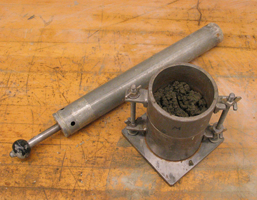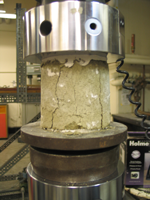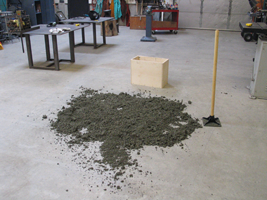





Laboratory Testing
The intent of the laboratory research was to identify a local soil that could be used for rammed earth in New England. During this phase we identified suitable soil types and created rammed earth samples to obtain data about compaction density, compressive strength, and erosion behavior.
Numerous sources consulted in the literature review suggested that a mineral subsoil consisting of thirty percent clay and seventy percent sand, gravel and fines was the material best suited to rammed earth. When investigations of subsoils within a fifteen mile radius of Boston showed no easily accessible, naturally-occurring soils with the necessary clay content, it was decided to utilize an engineered soil consisting of thirty percent Boston Blue Clay mixed with commercially available sand and gravel. In keeping with traditional and contemporary rammed earth methods in Europe, no Portland cement was used in the rammed earth portions of the wall. The clay is a dependable byproduct of construction in the metropolitan Boston area, where excavation contractors often must contend with its disposal when digging a deep foundation for a large building. Twelve tons of clay for the project was provided free of charge from the construction site of a new building at Harvard University by an excavation contractor.
Samples were created and tested in a variety of soil mixes stemming from this initial composition. The results of these tests developed a maximum unconfined compression of close to 300 psi, somewhat lower than expected, but easily strong enough to build walls of up to 10m high or more. Proctor compaction tests, which measure the moisture content necessary for maximum soil compaction, showed that mixing moist clay with dry sand and gravel in their natural states produced a soil whose moisture content was almost ideal for maximum compaction. Three rounds of freezing and thawing led to no noticeable degradation of samples, although further testing would be required to fully evaluate resistance of rammed earth to spalling. The results of initial laboratory testing were promising enough to warrant the construction of a full-scale wall on the campus of MIT.